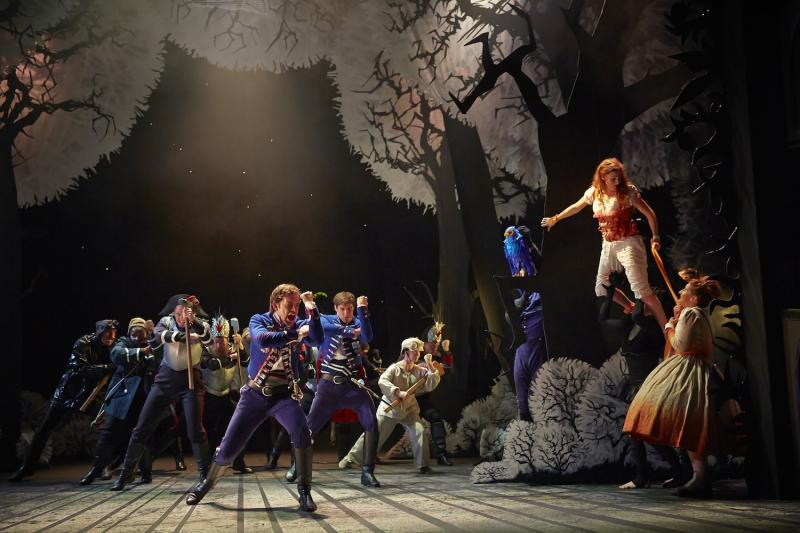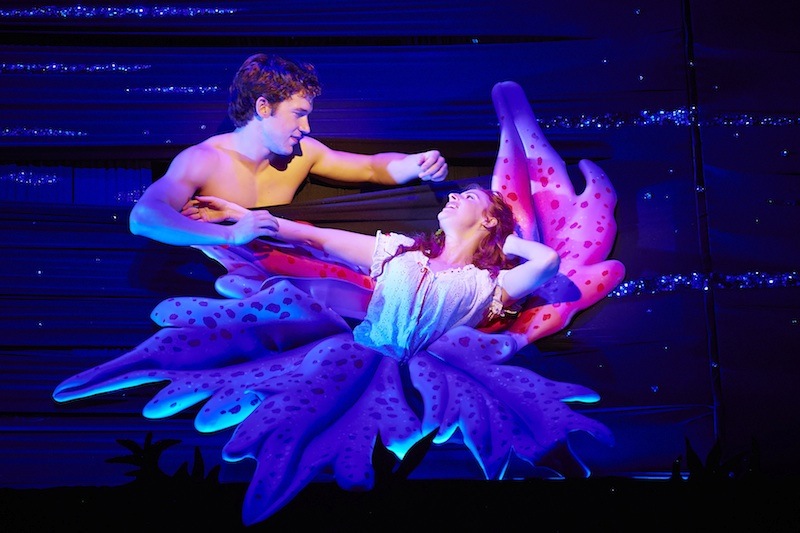The Light Princess, National Theatre | reviews, news & interviews
The Light Princess, National Theatre
The Light Princess, National Theatre
Will this take off? A fairytale musical rustled up by fêted songwriter Tori Amos and playwright Samuel Adamson

Once upon a time, there were two cultures, and they were at odds. A forested wilderness stretches between the kingdoms of Sealand and Lagobel, as we glean from the childishly-drawn, giant map that serves as a front cloth for the NT's new musical spectacular – directed by Marianne Elliot and opening in the Lyttelton last night. The map shows, on one side of the wilderness, Sealand’s coastal realm with winding rivers and a chateau bristling with turrets, all in shades of blue.
Co-written by Tori Amos (on music and lyrics) and the playwright Samuel Adamson (book and lyrics), The Light Princess is loosely based on the Victorian story of the same name penned by George MacDonald. The titular heroine, Rosalie Craig’s Althea, is the adolescent daughter of Lagobel’s King Darius. Her mother died when she was little, at which she remained dry-eyed, determined to rise above grief. Also, her father (played by Clive Rowe) has long ignored her, prizing only his male heir. As a result, she has taken to surreally bobbing around in mid-air like a balloon, insisting on levity.
This pantomime-influenced production is trying to appeal to everyone across different classes and age groups
Holed up in a chamber lined with storybooks, Craig’s reclusive Althea floats aloft. It’s a delightful trompe l’oeil as she appears to waft around weightlessly, in her bloomers, with languid limbs and auburn tresses. She is, in fact, being kept in suspension by a clutch of strongmen who are hooked on to the bookshelves halfway up and dressed in black, so they’re virtually invisible. This is a novel kind of hand-held, human puppetry presented by Elliott who previously, of course, co-directed War Horse.
Later, Althea flees her father’s regime. She meets Nick Hendrix’s Digby, the Prince of Sealand, in the forest, where he’s on the march with an invading army. Meant to be gravity personified, he is heavy-hearted due to his mother’s death. Yet Althea makes him smile. The scene where they fall for each other – or rather rise and fall for each other – exquisitely uses aerial acrobatics to express amorousness (with movement direction by Steven Hoggett). Craig is hovering overhead, now wire-flying but tethered to Hendrix by a silk ribbon. Whilst intending to keep her distance, she keeps being softly drawn down to him in a kind of courtship dance that, in turn, lifts him off the ground.
Alas, other elements of this production fall disappointingly flat. Overall, there’s more stylized choreography than real sexual chemistry or characterization. As for Amos’ contribution, her track record as a Grammy-nominated singer/songwriter – particularly her folk-influenced hit single “A Sorta Fairytale” – inspired high hopes.
However, the songs punctuating The Light Princess (orchestrated by Amos and Martin Lowe in conjunction with John Philip Shenale) sound plodding, schmaltzy and sub-Lloyd Webber in the main. They’re not strikingly original, only occasionally rousing.
 Rosalie Craig's Althea reclines on a water lilly, in the swim with Nick Hendrix's Digby
Rosalie Craig's Althea reclines on a water lilly, in the swim with Nick Hendrix's Digby
The lyrics surely aren’t going to be winning any awards, rhyming “See my tears flow” with “H20” when Althea learns to feel deeply. The storyline is scrambled too, even after premiere-delaying rewrites. What Althea’s floating represents is interestingly complex (mirthfulness, political irresponsibility, spirited independence). Nonetheless, an attempt to embrace other readings (including drugs and anorexia) is clumsily managed.
Visually, Elliott’s multimedia team of designers are also hit and miss. I suspect this pantomime-influenced production is trying to appeal to everyone, across different classes and age groups. The set and costumes veer none too winningly, though, between the classy and the tacky. The forest is spookily beautiful, with moonlit trees like jagged coral, except the lake into which Althea and Digby plunge could hail from a Las Vegas cabaret devised by Barbie. It’s covered with cheap glitter and lurid pink water lilies – or were they splashes of exotic vomit?
I suppose my aesthetic complaints might be countered by the story’s final message: a plea for cultural divisions to be surmounted. However, the ecological credo that’s attached to that conclusion – saying we must protect the natural environment – might have carried more weight if that pond had been prettier.
- The Light Princess at the National Theatre to 9 January
Follow Kate Bassett on Twitter
Overleaf: watch Tori Amos's video for "A Sorta Fairytale"
rating
Explore topics
Share this article
Add comment
Subscribe to theartsdesk.com
Thank you for continuing to read our work on theartsdesk.com. For unlimited access to every article in its entirety, including our archive of more than 15,000 pieces, we're asking for £5 per month or £40 per year. We feel it's a very good deal, and hope you do too.
To take a subscription now simply click here.
And if you're looking for that extra gift for a friend or family member, why not treat them to a theartsdesk.com gift subscription?
more Theatre
 Red Speedo, Orange Tree Theatre review - two versions of American values slug it out
Timely arrival for Lucas Hnath's play about the cost of winning
Red Speedo, Orange Tree Theatre review - two versions of American values slug it out
Timely arrival for Lucas Hnath's play about the cost of winning
 ECHO, LIFT 2024, Royal Court review - enriching journey into the mind of an exile
Nassim Soleimanpour's latest 'cold read' work is a unique experience
ECHO, LIFT 2024, Royal Court review - enriching journey into the mind of an exile
Nassim Soleimanpour's latest 'cold read' work is a unique experience
 The Hot Wing King, National Theatre review - high kitchen-stove comedy, with sides of drama
Katori Hall is back in her native Memphis with an exuberant ensemble piece
The Hot Wing King, National Theatre review - high kitchen-stove comedy, with sides of drama
Katori Hall is back in her native Memphis with an exuberant ensemble piece
 Hello, Dolly!, London Palladium review - Imelda Staunton makes every line a deal-broker
Operettaish bitter-sweetness raised to the sublime in a miracle of perfect timing
Hello, Dolly!, London Palladium review - Imelda Staunton makes every line a deal-broker
Operettaish bitter-sweetness raised to the sublime in a miracle of perfect timing
 The Baker's Wife, Menier Chocolate Factory review - loving reappraisal doesn't entirely, well, rise
An imperfect show arrives boasting a quasi-immersive charm
The Baker's Wife, Menier Chocolate Factory review - loving reappraisal doesn't entirely, well, rise
An imperfect show arrives boasting a quasi-immersive charm
 More Than One Story review - nine helpings of provocative political theatre
Cardboard Citizens shine an unforgiving light on poverty in the UK
More Than One Story review - nine helpings of provocative political theatre
Cardboard Citizens shine an unforgiving light on poverty in the UK
 Visit from an Unknown Woman, Hampstead Theatre review - slim, overly earthbound slice of writer's angst
Christopher Hampton's love of Stefan Zweig's text becomes a drawback
Visit from an Unknown Woman, Hampstead Theatre review - slim, overly earthbound slice of writer's angst
Christopher Hampton's love of Stefan Zweig's text becomes a drawback
 Grud, Hampstead Theatre review - sparky investigation of a geeky friendship
Two awkward science nerds and a violent alcoholic father are oddly likeable company
Grud, Hampstead Theatre review - sparky investigation of a geeky friendship
Two awkward science nerds and a violent alcoholic father are oddly likeable company
 Skeleton Crew, Donmar Warehouse review - slow burn that satisfyingly catches fire
A fine cast spell out the cost of survival in today's ailing industries
Skeleton Crew, Donmar Warehouse review - slow burn that satisfyingly catches fire
A fine cast spell out the cost of survival in today's ailing industries
 Next to Normal, Wyndham's Theatre review - rock musical on the trauma of mental illness
Award-winning production comes to West End - bring your handkerchiefs
Next to Normal, Wyndham's Theatre review - rock musical on the trauma of mental illness
Award-winning production comes to West End - bring your handkerchiefs
 Mnemonic, Olivier Theatre review - thanks for the memories
Complicité’s reflection on memory, connection and storytelling remains as potent as ever
Mnemonic, Olivier Theatre review - thanks for the memories
Complicité’s reflection on memory, connection and storytelling remains as potent as ever
 Starlight Express, Troubadour Wembley Park Theatre review - freight is kinda great
Andrew Lloyd Webber's 1980s spectacular skates into a new era
Starlight Express, Troubadour Wembley Park Theatre review - freight is kinda great
Andrew Lloyd Webber's 1980s spectacular skates into a new era

Comments
Is this a review or a
Criticising a production for
When it comes to music
some of the worst music- and
Perhaps you need training in